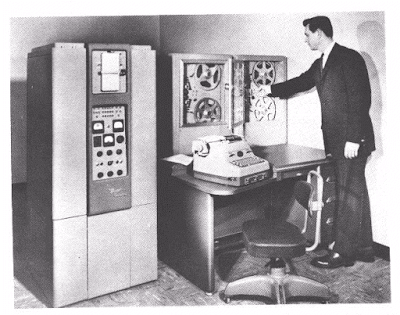5 computer generations Exist
till Date Now. Each generation has been discussed in detail in this article.
► First Generation
The Time period of first
generation was 1946-1959. The first generation used vacuum tubes as basic
components for memory and circuitry for CPU. These tubes, produced a lot of
heat they were expensive and could only be afforded only by large organizations.
In this generation usually batch processing OS were used. Punched cards, magnetic
tape and paper tapes were used as I/O devices. The machine code was used in
this generation as programming language.
The main features of first generation are:
§ Vacuum tube were used
§ Unreliable
§ Consume lot of electricity
§ Only machine language supported
§ Very costly
§ Generated lot of heat
§ Slow I/O devices
§ Their size was Huge size
§ Non-portable
Some computers of this generation were:
§ UNIVAC
§ IBM-701
§ IBM-650
► Second Generation
The Time period of 2nd
generation was 1959-1965. Transistors were used in this generation that were consumed
less power and were cheaper, more compact in size then 1st
generation, faster and reliable then the first generation. Magnetic cores were
used as primary memory and magnetic disks and magnetic tape were used as
secondary storage devices in this generation. Assembly language and high-level
programming languages like COBOL, FORTRAN were used in 2nd
generation. The computers used multiprogramming OS and batch processing.
The main features of second generation are:
v Transistors were used
v Reliable as compare to 1st
generation computers
v Smaller in size then first
generation computers
v Generated less amount of
heat as compared to 1st generation computers
v Consumed less amount electricity
as compared to 1st generation
computers
v Faster than 1st
generation computers
v Very costly
v A.C. needed
v Supported assembly and machine
languages
Some computers of this generation were:
§ IBM 1620
§ IBM 7094
§ CDC 3600
► Third Generation
The Time period of 3rd
generation was 1965-1971. Integrated circuits (IC's) were used in place of
transistors. A single IC chip has many resistors, capacitors and transistors.
The development of IC made size of computers smaller and made them reliable and
efficient. Remote processing, multi-programming OS, time-sharing, were used in
this generation. High-level languages like FORTRAN-II TO IV, COBOL, PASCAL,
BASIC, etc. were used in this generation
The main features of third generation are:
v IC were used
v More reliable than previous
two generations
v Smaller size than previous
two generations
v Generated less heat
v Faster
v Need Lesser maintenance
v Costly
v Consumed lesser electricity
than previous two generations
v Supported high-level
language
Some computers of this generation were:
§ IBM-360 series
§ IBM-370/168
§ PDP(Personal Data Processor)
► Fourth Generation
The time period of 4th
generation was 1971-1980. The 4th generation computers used Very
Large Scale Integrated (VLSI) circuits. VLSI circuits have about 5000
transistors and other elements and associated circuits on a single chip. VLSI
circuits made it possible to have microcomputers of 4th generation. 4th
generation computers became more reliable, compact, powerful, and affordable. And
it gave rise to personal computer (PC) revolution. In this generation real
time, time sharing, networks, distributed OS were used. All the high-level
languages were used in this generation like C, C++ and DBASE etc.
The main features of fourth generation are:
v VLSI were used
v They are Very cheap
v Reliable and Portable
v Use of Personal Computers
v Very small size
v Internet was introduced
v Computers became easily
available
Some computers of this generation were:
§ STAR 1000
§ PDP 11
§ CRAY-1(Super Computer)
► Fifth Generation
The time period of 5th generation is 1980-till
date. In the 5th generation, VLSI technology turned into ULSI (Ultra
Large Scale Integration) technology, resulting in the development of
microprocessor chips having 10million electronic components. This generation is
based on AI (Artificial Intelligence) software and parallel processing hardware.
All the high-level languages are used in this generation like C and C++, Java,
.Net etc.
The main features of fifth generation are:
v ULSI technology
v Development of true
artificial intelligence
v Development of Natural
language processing
v Advancement in Parallel Processing
v Advancement in
Superconductor technology
v More user friendly
interfaces with multimedia features
v Availability of very
powerful and compact computers at cheaper rates
Some computer types of this generation are:
§ Desktop
§ Laptop
§ NoteBook




















0 comments :